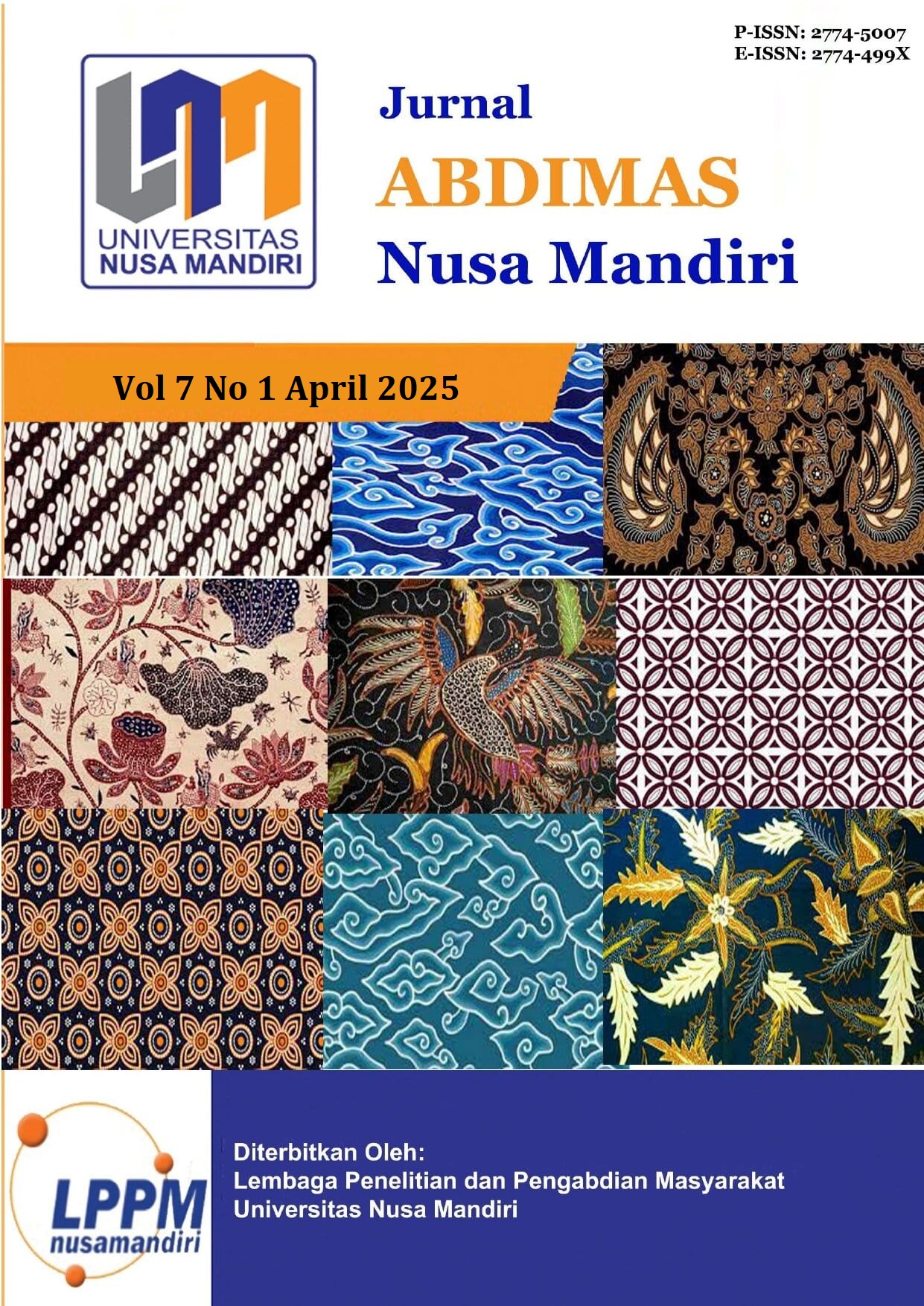PELATIHAN APLIKASI BANK SAMPAH BERBASIS WEB PADA BANK SAMPAH BERKAH SEJAHTERA DESA RAWA PANJANG
DOI:
https://doi.org/10.33480/abdimas.v7i1.6112Keywords:
application, customer, waste bank, webAbstract
At Berkah Sejahtera Waste Bank, the service process is still carried out manually, namely by recording in the waste bank book so that data accuracy and timeliness often have errors in management. To find solutions to existing problems, it is necessary to have a computerized data management system in a waste bank institution as an effort to accelerate the processing of waste bank management transaction data that can provide convenience in carrying out transaction activities, managing Berkah Sejahtera Waste Bank savings, and creating transparency and accountability in the Berkah Sejahtera waste bank management unit in the Rawa Panjang Village area, Bojong Gede, Kabupaten Bogor. The applied method includes partner needs analysis, development of a digital waste bank application, training on application usage, and evaluation of the training outcomes. This application training activity was attended by 34 participants consisting of representatives of the management, and customers of the Berkah Sejahtera Waste Bank. The result of this training is an increase in the usefulness of training by 88% and feedback in using the E-BAS application recorded at 91.18% This waste bank application is a web-based data processing that can speed up and facilitate Waste Bank officers in conducting transactions, processing customer savings data, updated, transparent, and informative information and can be accessed at any time.
References
Sukmaniar, Wahyu Saputra, Muhammad Hapiz Hermansyah, and P. Anggraini, “Bank Sampah Sebagai Upaya Pengelolaan Sampah Di Perkotaan,” Environ. Sci. J. J. Ilmu Lingkung., vol. 1, no. 2, pp. 61–67, 2023, doi: 10.31851/esjo.v1i2.11960.
A. Zahra and et al, “Transformasi Digital Di Masyarakat Desa: Tantangan Dan Peluang Menuju Terwujudnya Sdgs 2030,” J. Multidisiplin Ilmu Akad., vol. 1, no. 3, pp. 93–99, 2024, doi: 10.61722/jmia.v1i3.1364.
CME, “Inpres RI Nomor 3 Tahun 2001,” 2017, pp. 1–11, 2001.
J. Junaidi and A. A. Utama, “Analisis Pengelolaan Sampah Dengan Prinsip 3R (Reduce, Reuse, Recycle) (Studi Kasus Di Desa Mamak Kabupaten Sumbawa),” JISIP (Jurnal Ilmu Sos. dan Pendidikan), vol. 7, no. 1, pp. 706–713, 2023.
K. Lingkungan, Menteri Dan, Hidup Republik, “Permen_LHK_14_Th_2021_Pengelolaan sampah,” Simba.menlhk, 2021.
Z. Zuraidah, L. N. Rosyidah, and R. F. Zulfi, “Edukasi Pengelolaan Dan Pemanfaatan Sampah Anorganik Di Mi Al Munir Desa Gadungan Kecamatan Puncu Kabupaten Kediri,” Budimas J. Pengabdi. Masy., vol. 4, no. 2, pp. 1–6, 2022, doi: 10.29040/budimas.v4i2.6547 .
Nurhayati, Y. S. Dewi, K. Kusumawati, W. Kurniawan, and P. Hendradi, “Pelatihan Kerajinan Tangan Dari Kemasan Sachet Minuman di Warga 09 Kelurahan Kebayoran Lama Utara Kecamatan Kebayoran Lama Jakarta Selatan,” Kocenin J. Pengabdi. Kpd. Masy., vol. 2, pp. 32–40, 2022.
Y. Sapta Dewi, “Pelatihan Dan Sosialisasi ‘Sampah Adalah Berkah,’” J. Sinergi, vol. 3, no. 2, pp. 9–24, 2023, doi: 10.59134/sinergi.v3i2.409.
R. Nirmalasari et al., “Pemanfaatan Limbah Sampah Plastik Menggunakan Metode Ecobrick di Desa Luwuk Kanan,” J. SOLMA, vol. 10, no. 3, pp. 469–477, 2021, doi: 10.22236/solma.v10i3.7905.
N. P. Decy Arwini, “Sampah Plastik Dan Upaya Pengurangan Timbulan Sampah Plastik,” J. Ilm. Vastuwidya, vol. 5, no. 1, pp. 72–82, 2022, doi: 10.47532/jiv.v5i1.412.
Aliansi Zero Waste, “Menelusuri Jejak Karbon dari Produksi Plastik,” AZWI, Indonesia, 2023.
Asnaini, “No 18 Tahun 2008,” مUndang-undang RI tentang Pengelolaan Sampah, vol. 23, no. 45, pp. 5–24, 2008.
P. T. Kebijakan, “Kebijakan-Dan-Strategi-Daerah-Pengelolaan-Sampah-Rumah-Tangga-Dan-Sampah-Sejenis-Sampah-Rumah-Tangga27.Pdf,” 2017.
K. Kamelia, R. Reskiana, R. Rahmi, and A. Lubis, “Perkembangan Teknologi Komunikasi dan Informasi Akar Revolusi di Sekolah Dasar,” Indones. Gend. Soc. J., vol. 3, no. 1, pp. 13–18, 2022, doi: 10.23887/igsj.v3i1.42417.
S. Shodiq, “Peran Sistem Informasi dan Teknologi Informasi terhadap Proses Pembelajaran di Masa Pandemi Covid-19,” J. Edukasi, vol. 8, no. 1, p. 17, 2021.
F. H. Rahmah and T. Theresiawati, “Aplikasi Bank Sampah Berkah Melimpah Berbasis Website pada Kelurahan Nanggewer,” Inform. J. Ilmu Komput., vol. 18, no. 2, p. 131, 2022, doi: 10.52958/iftk.v18i2.4641.
M. Marzuki, M. Hasibuan, D. T. W, R. Rizal, and W. R. Lestari, “Perancangan Aplikasi Bank Sampah Berbasis Website Untuk Kampus Bebas Sampah,” J. Digit. Lit. Volunt., vol. 2, no. 1, pp. 23–30, 2024.
A. Muhammad et al., “Sistem Informasi Berbasisweb Aplikasi E-Trash Bank Sampah,” vol. 1, no. 2, pp. 74–81, Dec. 2020, doi: 10.31294/reputasi.v1i2.94.
Downloads
Published
How to Cite
Issue
Section
License
Copyright (c) 2025 Prionggo Hendradi, Wawan Kurniawan, Yusriani Sapta Dewi, Kiki Kusumawati, Nurhayati Nurhayati, Nurul Chafid

This work is licensed under a Creative Commons Attribution-NonCommercial 4.0 International License.
Dengan mengirimkan manuskrip ke Jurnal AbdiMas Nusa Mandiri, penulis setuju dengan kebijakan ini. Tidak diperlukan persetujuan dokumen khusus.
Hak Cipta :
Hak cipta atas artikel apa pun di Jurnal AbdiMas Nusa Mandiri dipegang penuh oleh penulisnya di bawah lisensi Creative Commons CC BY-NC.
- Hak cipta pada setiap artikel adalah milik penulis.
- Penulis mempertahankan semua hak mereka atas karya yang diterbitkan, tak terbatas pada hak-hak yang diatur dalam laman ini.
- Penulis mengakui bahwa Jurnal AbdiMas Nusa Mandiri sebagai yang pertama kali mempublikasikan dengan lisensi Creative Commons Atribusi 4.0 Internasional (CC BY-NC).
- Penulis dapat memasukan tulisan secara terpisah, mengatur distribusi non-ekskulif dari naskah yang telah terbit di jurnal ini kedalam versi yang lain (misal: dikirim ke respository institusi penulis, publikasi kedalam buku, dll), dengan mengakui bahwa naskah telah terbit pertama kali pada Jurnal AbdiMas Nusa Mandiri;
- Penulis menjamin bahwa artikel asli, ditulis oleh penulis yang disebutkan, belum pernah dipublikasikan sebelumnya, tidak mengandung pernyataan yang melanggar hukum, tidak melanggar hak orang lain, tunduk pada hak cipta yang secara eksklusif dipegang oleh penulis.
- Jika artikel dipersiapkan bersama oleh lebih dari satu penulis, setiap penulis yang mengirimkan naskah menjamin bahwa dia telah diberi wewenang oleh semua penulis bersama untuk menyetujui hak cipta dan pemberitahuan lisensi (perjanjian) atas nama mereka, dan setuju untuk memberi tahu rekan penulis persyaratan kebijakan ini. Jurnal AbdiMas Nusa Mandiri tidak akan dimintai pertanggungjawaban atas apa pun yang mungkin timbul karena perselisihan internal penulis.













